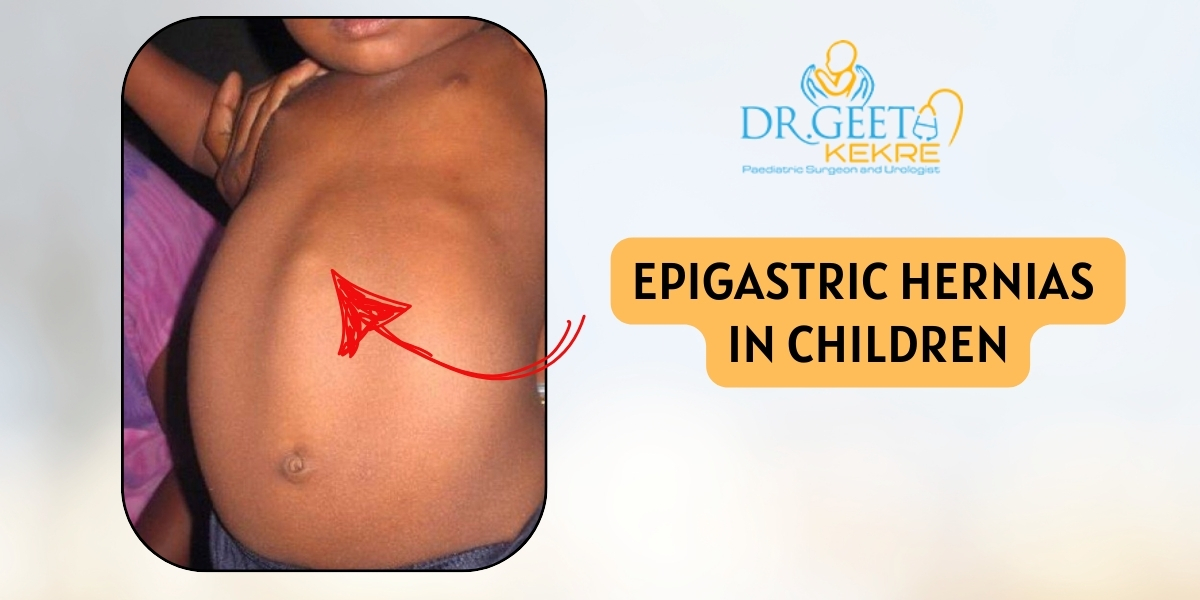Epigastric hernias in children, though uncommon, are a critical medical concern that warrants a comprehensive understanding. These hernias occur in the upper abdominal region, between the belly button and the lower part of the ribcage. Understanding the causes, symptoms, diagnostic approaches, and treatment options is essential for parents and caregivers to ensure timely and effective medical intervention.
What is an Epigastric Hernia?
An epigastric hernia is a protrusion of fatty tissue or part of the intestine through a weakened area in the abdominal wall. This condition is most commonly found in the epigastric region and may present as a small lump or swelling that can be seen or felt. The hernia may increase in size during activities such as crying, coughing, or straining.
In children, these hernias are typically congenital, meaning they are present at birth due to developmental defects during fetal growth. While epigastric hernias are often asymptomatic, they can sometimes cause discomfort or complications that require medical attention.
Causes of Epigastric Hernias in Children
Epigastric hernias are primarily caused by weakness or incomplete closure of the abdominal muscles during fetal development. Factors contributing to this condition include:
- Congenital Weakness: A natural defect in the abdominal wall present from birth.
- Strain or Pressure: Activities that increase abdominal pressure, such as heavy crying or straining, may exacerbate the condition.
- Genetic Factors: A family history of hernias may predispose children to develop epigastric hernias.
Symptoms of Epigastric Hernias
While some children with epigastric hernias may remain asymptomatic, others may exhibit noticeable signs. Common symptoms include:
- Visible Lump: A small, tender swelling in the upper abdominal region, particularly noticeable when the child strains.
- Pain or Discomfort: Mild to moderate pain, especially during activities that involve abdominal pressure.
- Nausea or Vomiting: In severe cases, trapped tissue may lead to gastrointestinal symptoms.
If symptoms such as severe pain, redness, or difficulty in movement appear, immediate medical attention is necessary.
Diagnosing Epigastric Hernias
Diagnosing an epigastric hernia typically involves a physical examination by a pediatric specialist. During the examination, the doctor may palpate the abdominal area to identify the hernia. If further clarity is needed, imaging techniques such as ultrasound or CT scans may be employed to assess the size, location, and contents of the hernia.
Accurate diagnosis is crucial to determine the appropriate course of action and to prevent complications like incarceration or strangulation of the hernia.
Treatment Options for Epigastric Hernias in Children
The treatment for epigastric hernias in children depends on factors such as the size of the hernia and the severity of symptoms.
Non-Surgical Management
In some cases, small and asymptomatic hernias may be monitored for any changes. Regular follow-ups with the healthcare provider ensure that the condition does not worsen over time.
Surgical Repair
For symptomatic or large hernias, surgery is the definitive treatment. The procedure typically involves:
- Herniorrhaphy: The hernia is repositioned into the abdominal cavity, and the defect in the abdominal wall is closed with sutures.
- Mesh Repair: In some cases, a synthetic mesh is used to strengthen the abdominal wall and prevent recurrence.
Pediatric hernia repair is a safe and effective procedure, with most children recovering quickly and resuming normal activities within a few weeks.
Complications Associated with Untreated Epigastric Hernias
Failing to address an epigastric hernia can lead to serious complications, including:
- Incarceration: The hernia becomes trapped and cannot be pushed back into the abdomen, causing significant pain and swelling.
- Strangulation: A trapped hernia may lose its blood supply, leading to tissue death and requiring emergency surgery.
- Chronic Discomfort: Persistent pain or irritation can affect the child’s quality of life.
Early diagnosis and treatment are essential to avoid these complications.
Postoperative Care and Recovery
After surgical repair of an epigastric hernia, careful postoperative care is vital to ensure a smooth recovery. Parents should follow these guidelines:
- Rest and Activity Restrictions: Limit strenuous activities for a few weeks to allow proper healing.
- Wound Care: Keep the surgical site clean and dry to prevent infection.
- Follow-Up Visits: Regular check-ups with the surgeon to monitor recovery progress.
With proper care, most children recover fully and experience no long-term issues.
Preventing Epigastric Hernias
While congenital epigastric hernias cannot always be prevented, certain measures can reduce the risk of complications or recurrence:
- Timely Treatment: Address hernias promptly to prevent worsening.
- Healthy Lifestyle: Ensure the child maintains a balanced diet and avoids excessive straining.
- Routine Check-Ups: Regular pediatric visits can help in early detection of potential issues.

